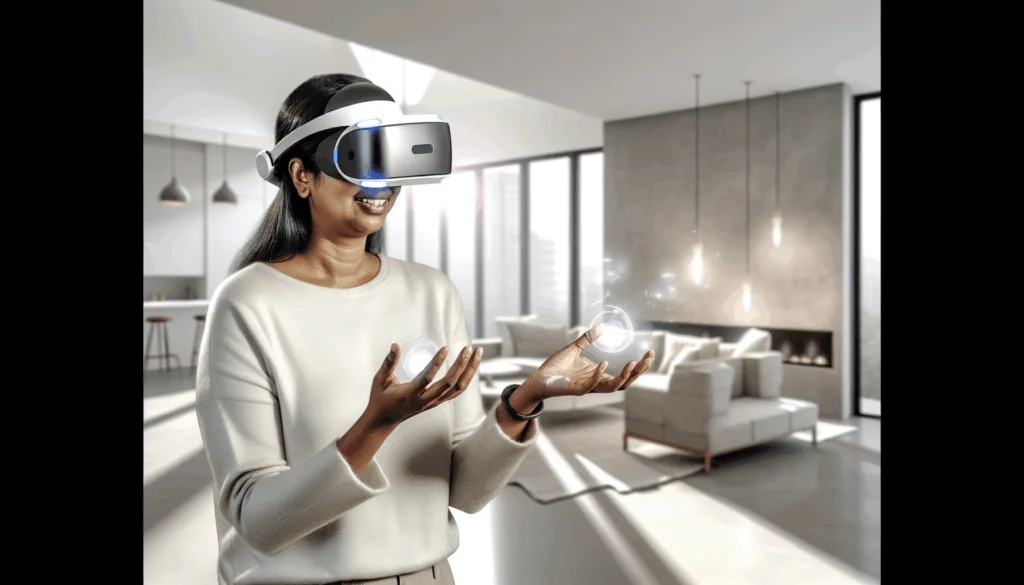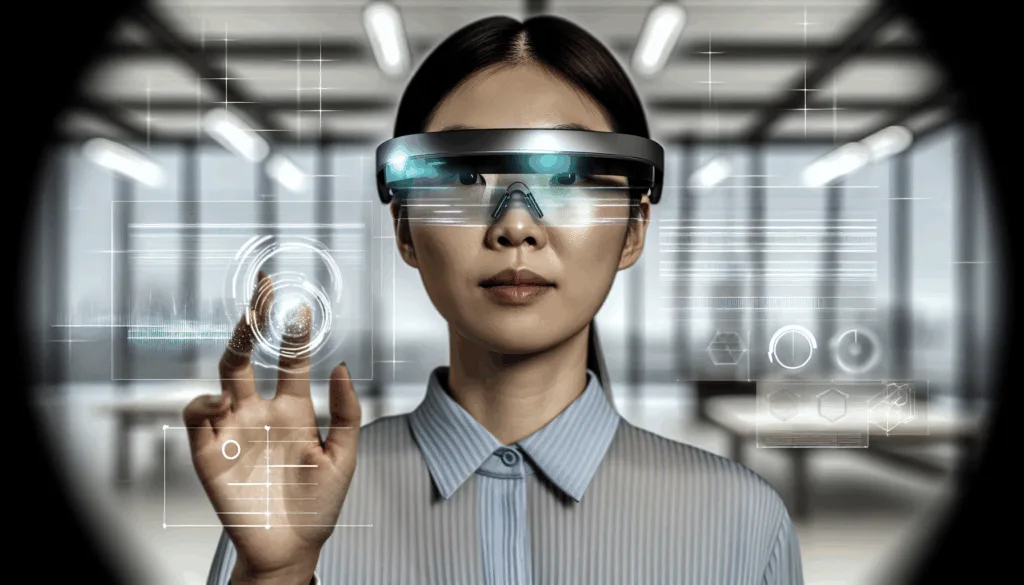The digital frontier is no longer a distant horizon; it’s a rapidly expanding landscape, increasingly merging with our physical world. For years, Augmented Reality (AR) and Virtual Reality (VR) have captivated our imaginations, promising new dimensions of interaction, entertainment, and productivity. While early iterations often felt like intriguing prototypes, 2025 marks a pivotal year – a true inflection point where these immersive technologies transition from niche curiosities to indispensable tools, fundamentally reshaping how we live, work, and connect.
This isn’t just about higher resolution or wider fields of view; it’s about a holistic revolution in sensory and spatial computing. We’re witnessing the culmination of decades of research, fueled by breakthroughs in processing power, display technology, haptics, and artificial intelligence. The gadgets emerging in 2025 are not mere upgrades; they are sophisticated portals to parallel realities, offering unparalleled immersion and utility. Join us as we delve into the cutting-edge devices poised to define the AR/VR revolution, exploring the innovations that make them the best immersive gadgets of 2025.
The Dawn of True Immersion: Setting the Stage for 2025
The journey of AR/VR has been a fascinating one, evolving from rudimentary headsets and clunky peripherals to sleek, powerful, and increasingly intuitive devices. Early pioneers laid the groundwork, demonstrating the raw potential, but it’s the advancements in foundational technologies over the last few years that have truly set the stage for the transformative experiences we’ll see in 2025. Miniaturization of components, significant leaps in battery efficiency, and the maturation of spatial tracking algorithms have collectively enabled a new generation of hardware that is finally ready for widespread adoption.
This era marks a significant shift from AR/VR being a "cool novelty" to becoming a "practical utility." Beyond gaming and entertainment, these technologies are now seamlessly integrating into professional workflows, educational curricula, and even social interactions. Imagine surgeons practicing complex procedures in a virtual operating room, architects walking clients through photorealistic digital twins of unbuilt structures, or families connecting in shared virtual spaces that feel as real as being together. The focus has moved from simply seeing a digital world to being present within it, blurring the lines between the physical and the virtual.
Crucially, the convergence of AR/VR with other cutting-edge technologies like advanced AI, pervasive 5G connectivity, and robust cloud computing is amplifying their capabilities exponentially. AI-powered intelligent agents can populate virtual worlds, making interactions more dynamic and personalized. 5G and Wi-Fi 7 enable low-latency cloud rendering, offloading intensive processing from the device to powerful remote servers, allowing for lighter, more comfortable headsets without compromising graphical fidelity. This interconnected ecosystem is the bedrock upon which the truly immersive experiences of 2025 are built, promising persistent, dynamic, and incredibly rich digital environments.

The Pinnacle of VR Headsets: Beyond Resolution and Field of View
By 2025, the VR headset landscape is dominated by devices that have transcended the early limitations of resolution and field of view, pushing boundaries in display technology, optics, and ergonomic design. Micro-OLED and QLED panels, combined with advanced pancake optics, have enabled a dramatic reduction in headset bulk and weight, making prolonged use genuinely comfortable. These displays boast pixel densities so high that the "screen door effect" is a relic of the past, delivering crystal-clear visuals that are indistinguishable from reality, often exceeding 4K per eye with refresh rates of 120Hz or higher.
Beyond visual fidelity, the focus has shifted to enhancing the overall sense of presence. Advanced eye-tracking is now standard, enabling perfect foveated rendering where only the area of the display you’re directly looking at is rendered at maximum detail, significantly reducing computational load and allowing for more complex virtual worlds. Dynamic IPD (inter-pupillary distance) adjustment, often automated, ensures optimal visual alignment for every user, while integrated active cooling systems prevent discomfort during intense sessions. The integration of high-resolution color passthrough cameras has also become a critical feature, seamlessly blending virtual content with the real world, paving the way for true mixed reality experiences within a VR form factor.
The processing power within these standalone VR headsets is nothing short of remarkable. Custom-designed XR chipsets, often leveraging ARM architectures, now rival the capabilities of high-end gaming PCs from just a few years prior. This on-device processing prowess means complex simulations, photorealistic graphics, and intricate physics engines can run natively, untethered from external computers. This liberation from cables and external hardware is a game-changer, fostering a sense of freedom and mobility that is essential for truly immersive and intuitive interaction within virtual environments, whether for gaming, professional training, or social gatherings.
Augmented Reality’s Ascent: Blending Digital with Reality
While VR immerses us in entirely virtual worlds, Augmented Reality (AR) aims to enhance our existing reality by overlaying digital information directly onto our view of the physical world. In 2025, the dream of truly wearable AR glasses has largely been realized, moving far beyond the smartphone-based AR experiences of the past. Breakthroughs in waveguide technology and light field displays have enabled transparent lenses that are both lightweight and capable of projecting vibrant, persistent holograms directly into the user’s field of vision, making digital content appear as if it genuinely exists in the physical space.
The utility of these advanced AR glasses extends far beyond novelty. Imagine walking through a city and seeing real-time navigation arrows floating on the street, or historical information appearing next to landmarks. In industrial settings, technicians can receive step-by-step repair instructions overlaid directly onto machinery, while surgeons can view patient data and 3D anatomical models during operations. The critical development here is the ability to create "persistent AR anchors," meaning digital objects can be placed in real-world locations and remain there for all users, fostering shared spatial computing experiences that are contextually aware and highly collaborative.
Despite their incredible potential, AR glasses have faced unique challenges, primarily around battery life, social acceptance, and achieving a wide field of view without compromising transparency. By 2025, these issues have been significantly mitigated. Advances in micro-batteries and power-efficient chipsets allow for all-day use. Design aesthetics have evolved, making AR glasses indistinguishable from stylish eyewear, addressing social acceptance. While the field of view for high-fidelity AR remains a technical hurdle, significant improvements have been made, offering a comfortable and expansive viewing area that feels natural and unobtrusive, seamlessly blending digital information into our daily lives.

Haptics and Beyond: The Tactile Dimension of Immersion
Visual and auditory fidelity are crucial for immersion, but true presence demands tactile feedback. By 2025, haptic technology has moved far beyond simple vibrations in controllers, evolving into sophisticated systems that can recreate a nuanced sense of touch, texture, and even resistance. Advanced haptic gloves, often incorporating microfluidics or electro-tactile feedback, allow users to "feel" the weight of a virtual object, the texture of a digital surface, or the impact of a virtual collision with remarkable realism. This tactile dimension is indispensable for applications ranging from surgical training to virtual product design, where precise manipulation and sensory feedback are paramount.
The innovation doesn’t stop at gloves. Full-body haptic suits and vests are becoming more accessible, capable of delivering localized sensations across the user’s torso and limbs. Imagine feeling the gentle patter of virtual rain, the warmth of a digital campfire, or the force of a virtual punch. Some cutting-edge systems even integrate temperature control, adding another layer of sensory realism by simulating hot or cold environments. This multi-sensory approach significantly deepens the user’s connection to the virtual world, transforming passive observation into active, embodied participation.
Furthermore, the integration of advanced haptics with full-body tracking and sophisticated locomotion solutions (like omnidirectional treadmills or haptic floor tiles) creates a truly embodied immersive experience. Users can not only see and hear a virtual world but also walk through it, interact with it, and feel its nuances. This synergy is critical for applications requiring high levels of physical engagement, such as military simulations, sports training, or even just exploring vast virtual landscapes. The ability to touch and feel the digital world is the missing link that finally completes the illusion of presence, making virtual experiences feel genuinely real.
The Ecosystem Play: Software, Content, and Connectivity
Hardware, no matter how advanced, is only as good as the software and content it supports. In 2025, the AR/VR revolution is underpinned by robust, mature operating systems (like Apple’s xrOS, Meta’s Reality OS, or Google’s Android XR) and a thriving developer ecosystem. These platforms provide intuitive user interfaces, seamless app integration, and powerful development tools that empower creators to build increasingly complex and engaging experiences. The battle for open standards versus proprietary walled gardens continues, but there’s a growing recognition that interoperability and cross-platform compatibility are essential for the long-term growth and mainstream adoption of the metaverse.
The content landscape for AR/VR in 2025 is incredibly diverse and vibrant. Beyond blockbuster gaming titles, we’re seeing an explosion of professional applications, from collaborative virtual workspaces that redefine remote work to immersive educational modules that bring subjects to life. User-generated content platforms are flourishing, allowing anyone to create and share their own virtual worlds and experiences. Live events, concerts, and sports are routinely streamed in immersive 3D, offering front-row seats from anywhere in the world. This rich tapestry of content ensures that there’s something for everyone, driving sustained engagement and making AR/VR a daily part of many lives.
Underpinning this entire ecosystem is the relentless march of connectivity. The widespread deployment of 5G networks and the advent of Wi-Fi 7 are critical enablers for the next generation of immersive experiences. These high-bandwidth, low-latency technologies allow for seamless cloud rendering, where computationally intensive graphics are processed on remote servers and streamed to the headset, enabling lighter, more comfortable devices without sacrificing visual fidelity. They also facilitate massive multi-user experiences, allowing thousands of people to interact simultaneously within a single virtual space without lag or disruption. This robust connectivity transforms AR/VR from isolated experiences into a truly interconnected, persistent digital fabric.

Top Immersive Gadgets of 2025: A Comparative Look
Determining the "best" immersive gadgets of 2025 is inherently subjective, depending on individual needs and use cases – whether it’s for cutting-edge gaming, professional collaboration, or casual social interaction. However, certain devices stand out for their groundbreaking innovation, unparalleled performance, and exceptional user experience across various categories. These are the flagships that push the boundaries of what’s possible, setting the standard for the industry and showcasing the pinnacle of AR/VR technology available this year.
Leading the charge are devices that excel in specific domains while offering robust general-purpose capabilities. For instance, a hypothetical "Meta Quest Pro 3" might dominate the standalone VR market with its powerful custom chipset, advanced passthrough for mixed reality, and extensive content library, appealing to both consumers and businesses. Meanwhile, an "Apple Vision Pro 2" could redefine spatial computing with its unparalleled display fidelity, intuitive gesture controls, and seamless integration into Apple’s ecosystem, targeting professional creatives and high-end users.
Other contenders like a potential "Valve Index 3" might continue to lead in PC-tethered VR for hardcore gamers, emphasizing ultra-wide field of view and precise tracking, while a "Magic Leap 3" could solidify its position in the enterprise AR space with its robust spatial mapping and developer tools. These devices aren’t just about raw specifications; they represent a holistic approach to immersion, combining cutting-edge hardware with sophisticated software, ergonomic design, and a compelling content ecosystem to deliver truly transformative experiences.
Here’s a comparative look at some hypothetical top-tier immersive gadgets of 2025:
| Feature / Device | Meta Quest Pro 3 (Hypothetical) | Apple Vision Pro 2 (Hypothetical) | Valve Index 3 (Hypothetical) | Magic Leap 3 (Hypothetical) |
|---|---|---|---|---|
| Type | Standalone VR/MR | Standalone Spatial Computer | PC VR Headset | Standalone AR Glasses |
| Display | Dual 4K+ Micro-OLED, 120Hz | Dual 5K+ Micro-OLED, 90Hz/120Hz | Dual 2.5K LCD, 144Hz | Light Field, 1440p per eye |
| Field of View | ~110° Horizontal | ~100° Horizontal | ~130° Horizontal | ~70° Diagonal |
| Processor | Custom XR2 Gen 3 Equivalent | M3/M4 Series Chip | PC-Tethered (GPU Dependent) | Custom AR Processor |
| Passthrough | Full-Color, High-Res MR | Ultra High-Res, Zero Latency MR | Basic B&W (for guardian) | Full-Color, High-Fidelity AR |
| Eye/Hand Tracking | Advanced Eye & Hand Tracking | Precision Eye & Hand Tracking | Eye Tracking (Optional Module) | Precision Eye & Hand Tracking |
| Haptics | Advanced Controller Haptics | VisionOS Haptics, Spatial Audio | Valve Knuckles 2.0 Haptics | Integrated Haptic Feedback |
| Weight | ~650g | ~600g | ~800g | ~200g |
| Target Audience | Consumer, Business, Gaming | Professional, Creative, Premium | Enthusiast PC Gamers | Enterprise, Developers |
| Connectivity | Wi-Fi 7, Bluetooth 5.3 | Wi-Fi 7, Bluetooth 5.3, UWB | DisplayPort, USB-C | Wi-Fi 7, 5G (Optional) |
| Key Feature | Versatile MR, Content Ecosystem | Seamless Ecosystem Integration | Ultimate Gaming Immersion | Industrial & Collaborative AR |
Emerging Innovations: What’s Next on the Horizon?
While the gadgets of 2025 represent a significant leap, the pace of innovation in AR/VR shows no signs of slowing down. Beyond the current generation of devices, several groundbreaking technologies are on the cusp of transforming immersive experiences even further. One of the most exciting and potentially revolutionary areas is Brain-Computer Interfaces (BCIs). Early prototypes of BCIs are already demonstrating the ability to interpret neural signals for direct control of virtual objects or even to provide subtle sensory feedback directly to the brain. While ethical considerations and practical challenges remain, BCIs promise an unprecedented level of intuitive interaction, potentially eliminating the need for physical controllers altogether.
Another frontier in multi-sensory immersion involves the integration of olfactory and gustatory feedback systems. Imagine not just seeing a virtual forest but smelling the pine needles, or not just seeing a virtual meal but tasting its flavors. While highly complex to implement realistically and safely, research in these areas is progressing, with early devices capable of releasing specific scent profiles or stimulating taste buds through electrical impulses. These additions, even in rudimentary forms, would dramatically enhance the realism and emotional impact of virtual experiences, moving us closer to truly indistinguishable simulations of reality.
Finally, the role of Artificial Intelligence within immersive environments is set to become profoundly more sophisticated. We’re moving beyond simple NPCs (Non-Player Characters) to truly adaptive AI companions and digital inhabitants that learn from user interactions, exhibit complex behaviors, and even develop unique personalities. These intelligent agents could serve as personalized tutors in educational simulations, empathetic therapists in mental health applications, or dynamic adversaries in gaming. The integration of advanced AI will make virtual worlds feel more alive, responsive, and deeply personal, fostering connections that blur the lines between human and artificial intelligence.
Challenges and the Road Ahead
Despite the incredible advancements, the AR/VR revolution faces significant hurdles on its path to true ubiquity. Cost remains a primary barrier for many, with high-end devices still commanding premium prices. While more affordable options are emerging, widespread adoption will depend on further cost reductions and increased accessibility. The digital divide also poses a challenge, as not everyone has access to the high-speed internet and powerful computing resources necessary to fully leverage these immersive technologies. Furthermore, content standardization and interoperability across different platforms are crucial to prevent fragmentation and ensure a seamless user experience.
Beyond the technical and economic challenges, profound ethical considerations demand careful attention. Data privacy is paramount, as immersive devices collect vast amounts of personal data, including biometric information, eye-tracking patterns, and spatial understanding of users’ environments. Ensuring this data is handled responsibly and securely is critical. The psychological impact of prolonged immersion, potential for addiction, and the blurring of lines between reality and virtuality also raise important questions that society must address. Establishing clear guidelines for digital identity, ownership of virtual assets, and responsible content creation will be essential.
Ultimately, the road to true AR/VR ubiquity involves overcoming these challenges through continued innovation, thoughtful policy-making, and a focus on user-centric design. Miniaturization will make devices even lighter and less obtrusive, energy efficiency will extend battery life to days, not hours, and seamless integration into daily life will make these technologies feel as natural as using a smartphone. The future of AR/VR is not just about creating new gadgets; it’s about fundamentally enhancing human connection, creativity, and understanding, opening up new dimensions of experience that were once confined to the realm of science fiction.
Conclusion
The year 2025 stands as a landmark in the AR/VR revolution, marking a clear departure from experimental prototypes to truly sophisticated, consumer-ready immersive gadgets. We’ve witnessed a convergence of technological breakthroughs – from micro-OLED displays and pancake optics to advanced haptics and powerful XR chipsets – culminating in devices that offer unprecedented levels of visual fidelity, tactile feedback, and computational power. These aren’t just incremental upgrades; they are transformative tools poised to redefine how we interact with information, each other, and the world around us.
The key takeaways from this pivotal year are clear: the focus has shifted from raw specifications to holistic user experience, emphasizing comfort, seamless integration, and intuitive interaction. Both VR and AR are maturing rapidly, with VR offering unparalleled escapism and training environments, while AR seamlessly blends digital information into our physical reality, enhancing productivity and contextual awareness. The burgeoning content ecosystems, coupled with pervasive high-speed connectivity, are ensuring that these powerful devices have compelling applications across every facet of life, from entertainment and education to professional collaboration and social connection.
As we look beyond 2025, the journey continues, with emerging innovations like BCIs and multi-sensory feedback promising even deeper levels of immersion. While challenges around cost, accessibility, and ethics persist, the trajectory is undeniable. The AR/VR revolution is not merely about new gadgets; it’s about unlocking new dimensions of human potential, fostering richer connections, and expanding the very fabric of our reality. The immersive future is here, and it’s more profound than we ever imagined.

